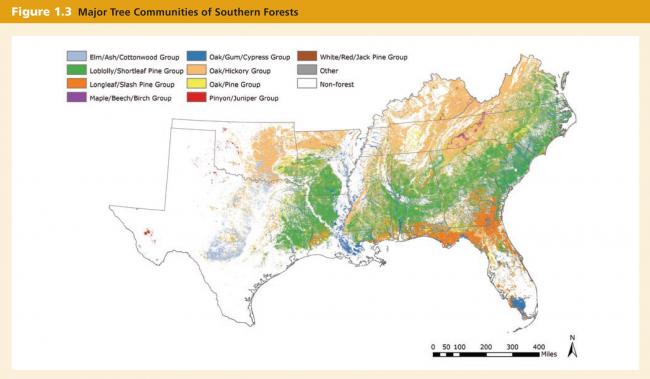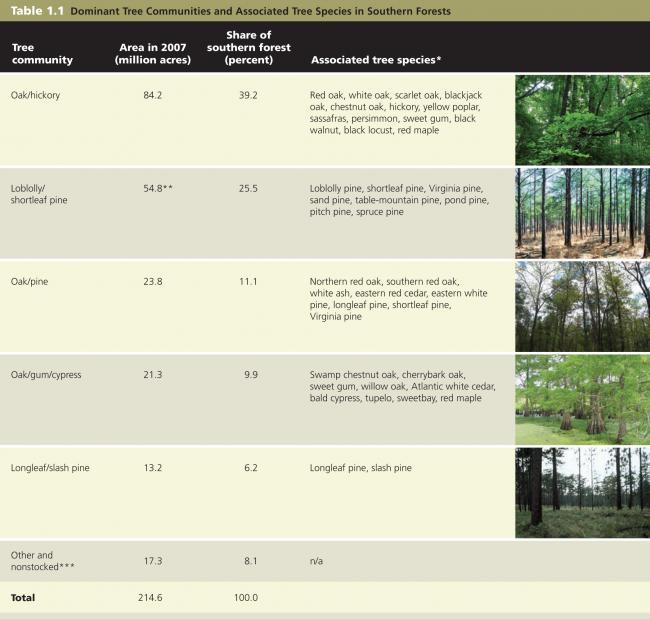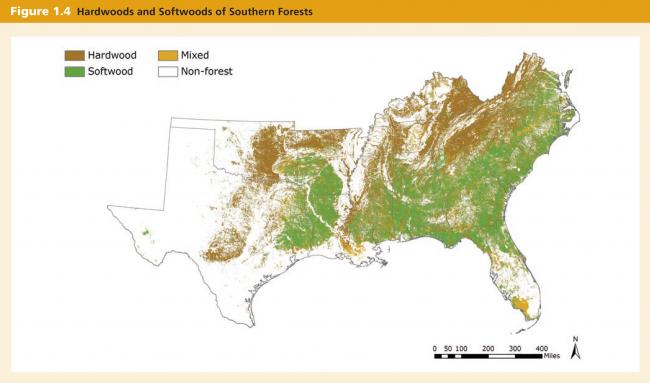Forests of Diversity
Southern U.S. forests (“southern forests”) are very diverse. They contain a range of dominant tree communities and species (Figure 1.3) that have changed in composition and extent over time as a result of both natural and human-influenced processes. The most common communities are oak/hickory, loblolly/shortleaf pine, oak/pine, and oak/gum/cypress (Table 1.1), which combined account for approximately 86 percent of southern forest area.1 Approximately 52 percent of the region’s forested area is dominated by hardwoods—deciduous broadleaf trees such as oaks. The remaining forest area is dominated by softwoods—evergreen coniferous trees such as pines—or a mixture of hardwoods and softwoods (Figure 1.4).
 Source: Source: Forest types (USDA Forest Service FIA and RSAC, 2008), administrative boundaries (ESRI Data and Maps 9.3.1, ESRI 2008).
Note: Data from satellite imagery taken in 2002 and 2003.
Source: Source: Forest types (USDA Forest Service FIA and RSAC, 2008), administrative boundaries (ESRI Data and Maps 9.3.1, ESRI 2008).
Note: Data from satellite imagery taken in 2002 and 2003. *Not exhaustive
**Acreage significantly influenced by forest management practices and does not reflect historic composition.
***Nonstocked is defined by timberland less than 10 percent stocked with all live trees.
Photos (top to bottom): Judy Baxter, Flickr; David Stephens, Bugwood.org; Hunter Desportes, Flickr; Kevin Trotman, Flickr; David J. Moorhead, University of Georgia, Bugwood.org
Source: Smith et al. 2009.
*Not exhaustive
**Acreage significantly influenced by forest management practices and does not reflect historic composition.
***Nonstocked is defined by timberland less than 10 percent stocked with all live trees.
Photos (top to bottom): Judy Baxter, Flickr; David Stephens, Bugwood.org; Hunter Desportes, Flickr; Kevin Trotman, Flickr; David J. Moorhead, University of Georgia, Bugwood.org
Source: Smith et al. 2009. Source: Forest types (USDA Forest Service FIA and RSAC, 2008), administrative boundaries (ESRI Data and Maps 9.3.1, ESRI 2008).
Note: Data from satellite imagery taken in 2002 and 2003.
Source: Forest types (USDA Forest Service FIA and RSAC, 2008), administrative boundaries (ESRI Data and Maps 9.3.1, ESRI 2008).
Note: Data from satellite imagery taken in 2002 and 2003.This range of tree communities helps make southern forests among the most biologically diverse temperate forests in the world. Southern forests contain the highest concentration of tree species in the United States. Southern forests and their environs support 3,000 species of plants2, 595 species of birds, and 246 species of mammals.3 As the home of 170 amphibian and 197 reptile species, these ecosystems are a center of amphibian and reptile diversity in North America.4
Southern forests are important not only for biodiversity, but also for people in the region and around the world. They supply lumber, plywood, and oriented strand board for construction, veneer for furniture, pulpwood for paper, and biomass fuel for industry and home heating. As a result, southern forests are the foundation for millions of jobs in the region. They protect water quality, prevent soil erosion, and help regulate climate by sequestering carbon dioxide—a major greenhouse gas. Furthermore, they offer places for people to hike, camp, hunt, and experience natural beauty. These forests support a wide range of ecosystem services.
-
Conner, Roger C., and Andrew J. Hartsell. 2002. “Forest Area and Conditions.” In Wear, David N., and John G, Greis, eds. Southern Forest Resource Assessment (2002). Gen. Tech. Rep. SRS-53. Asheville, NC: U.S. Department of Agriculture, Forest Service, Southern Research Station. ↩
-
Miller, James H. 2001. “Pine plantation communities: how do we begin to manage for plant diversity?” In: New Century: New Opportunities: Proceedings, 54th Annual Southern Weed Science Society meeting, January 22–24, 2001, Biloxi, Mississippi. Champaign, IL: Southern Weed Science Society. ↩
-
Trani, Margaret K. 2002a. “Maintaining Species in the South.” In Wear, David N., and John G, Greis, eds. 2002. Southern Forest Resource Assessment. Gen. Tech. Rep. SRS-53. Asheville, NC: U.S. Department of Agriculture, Forest Service, Southern Research Station. ↩
-
Trani, Margaret K. 2002a. “Maintaining Species in the South.” In Wear, David N., and John G, Greis, eds. 2002. Southern Forest Resource Assessment. Gen. Tech. Rep. SRS-53. Asheville, NC: U.S. Department of Agriculture, Forest Service, Southern Research Station. ↩



